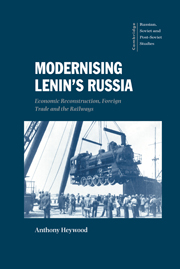Book contents
- Frontmatter
- Contents
- List of illustrations
- List of tables
- Acknowledgements
- Technical note
- List of abbreviations and acronyms
- Introduction
- PART I Towards economic reconstruction, 1917–1920 the birth of the railway imports policy
- 1 Prologue
- 2 The revolutionary railway vision
- PART II Trade and isolation, 1920–1921 implementing the railway imports policy
- PART III Retreat, 1921–1924
- Conclusion
- Notes
- Bibliography
- Index
- Cambridge Russian, Soviet and Post-Soviet Studies
- Plate Section
2 - The revolutionary railway vision
Published online by Cambridge University Press: 14 August 2009
- Frontmatter
- Contents
- List of illustrations
- List of tables
- Acknowledgements
- Technical note
- List of abbreviations and acronyms
- Introduction
- PART I Towards economic reconstruction, 1917–1920 the birth of the railway imports policy
- 1 Prologue
- 2 The revolutionary railway vision
- PART II Trade and isolation, 1920–1921 implementing the railway imports policy
- PART III Retreat, 1921–1924
- Conclusion
- Notes
- Bibliography
- Index
- Cambridge Russian, Soviet and Post-Soviet Studies
- Plate Section
Summary
If the condition of the Russian economy was frequently described as ‘critical’ during 1916 and ‘catastrophic’ in 1917, it was sometimes characterised as ‘supercatastrophic’ (sverkhkatastroficheskii) during the subsequent civil war. Superlatives were certainly appropriate. By December 1919, when the Bolsheviks were beginning to scent military victory, the output of the industrial sectors had collapsed to perhaps, on average, a quarter of 1913 levels. Agricultural output had also slumped, the transport sector seemed near final breakdown for want of serviceable rolling-stock and river barges, whilst foreign trade was virtually moribund from this internal crisis and an Allied naval blockade.
Yet for many engineers this appalling cloud had a silver lining. The revolution and the embattled atmosphere of War Communism excited utopian visions and social fantasies about dismantling the old order and building a new socialist world. For these engineers, widespread destruction and a technologically minded new government implied the possibility of radical technical and technological innovation. In particular, electrical engineers seized the moment to ‘spread the gospel of electrification for societal transformation’. According to Coopersmith, they gradually accumulated political support and developed theoretical rationales and organisational frameworks for nationwide electrification. Above all, their vision chimed with the revolutionary times in promising socioeconomic transformation, not simply reconstruction.
This vision of electrification challenged railway transport's traditional role as the pre-eminent agent of socioeconomic development. But railway engineers had their own vision. They too debated technical issues and wanted political support.
- Type
- Chapter
- Information
- Modernising Lenin's RussiaEconomic Reconstruction, Foreign Trade and the Railways, pp. 48 - 82Publisher: Cambridge University PressPrint publication year: 1999

